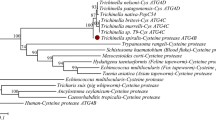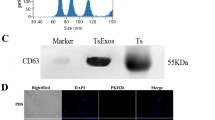Abstract
The activation of Trichinella spiralis muscle larvae (ML) by exposure to intestinal contents or bile and the intestinal epithelial cells (IECs) themselves are two pivotal requirements for the in vitro larval invasion of IECs. However, it is yet unknown which genes are involved in the process of larval invasion. The purpose of the present study was to analyze the differentially expressed genes of T. spiralis larvae activated by bile and cultured with IECs by using real-time polymerase chain reaction. Ten T. spiralis genes encoded the proteins produced by the larvae after co-culture with IECs were selected. Compared with untreated ML, four genes were up-regulated in both bile-activated and cell-cultured larvae, including calcium-dependent secretion activator (Csa; 2.55- and 16.04-fold, respectively), multi cystatin-like domain protein precursor (Mcd; 4.36 and 52), serine protease (Sp; 2.03 and 20.02), and intermediate filament protein ifa-1 (Ifa 1; 2 and 3.31). The expression of two genes, enolase (Eno; 1.51) and ribosomal protein S6 kinase beta-1 (Rsk; 1.49), was up-regulated only in cell-cultured larvae, not in bile-activated larvae. The expression of secreted 5′-nucleotidase (5 N; 1.42) and putative serine protease (Psp; 1.41) was up-regulated in bile-activated larvae, but was not changed or down-regulated after cultured with IECs. ATP synthase F1, beta subunit (ATPase; 0.58 and 0.51) and serine protease precursor (Spp; 0.42 and 0.65) were down-regulated in both bile-activated and cell-cultured larvae. This study provide some differentially expressed genes among the untreated (normal), bile-activated and cell-cultured larvae of T. spiralis. The up-regulated genes might be related with the larval invasion of IECs, but their exact biological functions need to be further investigated. This study will be helpful to further elucidate the molecular mechanism of the invasion of IECs by T. spiralis larvae and to better understand the interaction between parasite and host enterocytes.


Similar content being viewed by others
References
Bolás-Fernandez F, Corral-Bezara LD (2006) TSL-1 antigens of Trichinella: an overview of their potential role in parasite invasion, survival and serodiagnosis of trichinellosis. Res Vet Sci 81:297–303
Bruce RG (1970) Structure of the esophagus of the infective juvenile and adult Trichinella spiralis. J Parasitol 56:540–549
Campbell WC (1983) Trichinella and trichinosis. Plenum, New York
Chen X, Yang Y, Yang J, Zhang Z, Zhu X (2012) RNAi-mediated silencing of paramyosin expression in Trichinella spiralis results in impaired viability of the parasite. PLoS One 7:e49913. doi:10.1371/journal.pone.0049913
Cuttell L, Corley SW, Gray CP, Vanderlinde PB, Jackson LA, Traub RJ (2012) Real-time PCR as a surveillance tool for the detection of Trichinella infection in muscle samples from wildlife. Vet Parasitol 188:285–293. doi:10.1016/j.vetpar.2012.03.054
Dzik JM (2006) Molecules released by helminth parasites involved in host colonization. Acta Biochim Pol 53:33–64
Gagliardo LF, McVay CS, Appleton JA (2002) Molting, ecdysis, and reproduction of Trichinella spiralis are supported in vitro by intestinal epithelial cells. Infect Immun 70:1853–1859
Gamble HR, Bessonov AS, Cuperlovic K, Gajadhar AA, van Knapen F, Noeckler K, Schenone H, Zhu X (2000) International Commission on Trichinellosis: recommendations on methods for the control of Trichinella in domestic and wild animals intended for human consumption. Vet Parasitol 93:393–408
Guenther S, Nockler K, Von N, Rosenegk M, Landgraf M, Ewers C, Wieler LH, Schierack P (2008) Detection of Trichinella spiralis, T. britovi and T. pseudospiralis in muscle tissue with real-time PCR. J Microbiol Methods 75:287–292
Han CX, Liu HX, Zhao DM (2006) The quantification of prion gene expression in sheep using real-time RT-PCR. Virus Genes 33:359–364
Hartmann S, Lucius R (2003) Modulation of host immune responses by nematode cystatins. Int J Parasitol 33:1291–302
Hedstrom L (2002) Serine protease mechanism and specificity. Chem Rev 102:4501–4524. doi:10.1021/cr000033x
Jiang P, Wang ZQ, Cui J, Zhang X (2012) Comparison of artificial digestion and Baermann's methods for detection of Trichinella spiralis pre-encapsulated larvae in muscles with low-level infections. Foodborne Pathog Dis 9:27–31. doi:10.1089/fpd.2011.0985
Kang SA, Cho MK, Park MK, Kim DH, Hong YC, Lee YS, Cha HJ, Ock MS, Yu HS (2012) Alteration of helper T-cell related cytokine production in splenocytes during Trichinella spiralis infection. Vet Parasitol 186:319–327. doi:10.1016/j.vetpar.2011.12.002
Kapel CM, Gamble HR (2000) Infectivity, persistence, and antibody response to domestic and sylvatic Trichinella spp. in experimentally infected pigs. Int J Parasitol 30:215–21
Kenneth JL, Thomas DS (2001) Analysis of relative gene expression data using real-time quantitative PCR and the 2−ΔΔCt CT method. Methods 25:402–408
Li F, Cui J, Wang ZQ, Jiang P (2010) Sensitivity and optimization of artificial digestion in the inspection of meat for Trichinella spiralis. Foodborne Pathog Dis 7:879–885
Li CK, Seth R, Gray T, Bayston R, Mahida YR, Wakelin D (1998) Production of proinflammatory cytokines and inflammatory mediators in human intestinal epithelial cells after invasion by Trichinella spiralis. Infect Immun 66:2200–2206
Man Warren T, Gagliardo L, Geyer J, McVay C, Pearce-Kelling S, Appleton J (1997) Invasion of intestinal epithelia in vitro by the parasitic nematode Trichinella spiralis. Infect Immun 65(11):4806–4812
Murray J, Manoury B, Balic A, Watts C, Maizels RM (2005) Bm-CPI- 2, a cystatin from Brugia malayi nematode parasites, differs from Caenorhabditis elegans cystatins in a specific site mediating inhibition of the antigen-processing enzyme AEP. Mol Biochem Parasitol 139:197–203
Nagano I, Wu Z, Takahashi Y (2009) Functional genes and proteins of Trichinella spp. Parasitol Res 104:197–207. doi:10.1007/s00436-008-1248-1
Nagano I, Wu Z, Asano K, Takahashi Y (2011) Molecular cloning and characterization of transgelin-like proteins mainly transcribed in newborn larvae of Trichinella spp. Vet Parasitol 178:134–142
Newlands GF, Skuce PJ, Knox DP, Smith WD (2001) Cloning and expression of cystatin, a potent cysteine protease inhibitor from the gut of Haemonchus contortus. Parasitology 122:371–378
Ren HJ, Cui J, Wang ZQ, Liu RD (2011) Norma l mouse intestinal epithelial cells as a model for the in vitro invasion of Trichinella spiralis infective larvae. PLoS One 6:e27010
Ren HJ, Cui J, Yang W, Liu RD, Wang ZQ (2013a) Identification of differentially expressed genes in Trichinella spiralis larvae after exposure to host intestine milieu. PLoS One 8:e67570. doi:10.1371/journal.pone.0067570
Ren HJ, Liu RD, Wang ZQ, Cui J (2013b) Construction of a Trichinella spiralis phage display library and use for identifying the host enterocyte–parasite interactions. Parasitol Res 112:1857–1863. doi:10.1007/s00436-013-3339-x
Robinson MW, Connolly B (2005) Proteomic analysis of the excretory–secretory proteins of the Trichinella spiralis L1 larva, a nematode parasite of skeletal muscle. Proteomics 5:4525–4532
Romaris F, North SJ, Gagliardo LF, Butcher BA, Ghosh K, Beiting DP, Panico M, Arasu P, Dell A, Morris HR, Appleton JA (2002) A putative serine protease among the excretory–secretory glycoproteins of L1 Trichinella spiralis. Mol Biochem Parasitol 122:149–160
Schmittgen TD, Livak KJ (2008) Analyzing real-time PCR data by the comparative C (T) method. Nat Protoc 3:1101–1108
Stewart GL, Despommier DD, Burnham J, Raines KM (1987) Trichinella spiralis: behavior, structure, and biochemistry of larvae following exposure to components of the host enteric environment. Exp Parasitol 63:195–204
Theodoropoulos G, Petrakos G (2010) Trichinella spiralis: differential effect of host bile on the in vitro invasion of infective larvae into epithelial cells. Exp Parasitol 126:441–444
Theodoropoulos G, Prokou M, Georgiadou V, Petrakos M, Webster P, Kapel CM (2005) Effects of raw biles and their non-protein fractions from fox, pig, sheep and chicken on the survival of Trichinella spp. in vitro. Vet Parasitol 132:63–67
Wang N, Stamenović D (2000) Contribution of intermediate filaments to cell stiffness, stiffening, and growth. Am J Physiol Cell Physiol 279:C188–194
Wang L, Cui J, Wang SW, Wang ZQ (2010) Observation of the in vitro invasion of intestinal epithelial cells by Trichinella spiralis larvae and their development in those cells. J Pathog Biol 5:901–903
Wang SW, Wang ZQ, Cui J (2011) Protein change of intestinal epithelial cells induced in vitro by Trichinella spiralis infective larvae. Parasitol Res 108:593–599. doi:10.1007/s00436-010-2102-9
Wang ZQ, Wang L, Cui J (2012) Proteomic analysis of Trichinella spiralis proteins in intestinal epithelial cells after culture with their larvae by shotgun LC-MS/MS approach. J Proteomics 75:2375–2383. doi:10.1016/j.jprot.2012.02.005
Wang L, Wang ZQ, Cui J (2013a) Proteomic analysis of the changed proteins of Trichinella spiralis infective larvae after co-culture in vitro with intestinal epithelial cells. Vet Parasitol 194:160–163. doi:10.1016/j.vetpar.2013.01.045
Wang L, Wang ZQ, Cui J (2013b) Protein changes of Trichinella spiralis muscle larvae in vitro induced by bovine bile. Vet Parasitol 194:164–167. doi:10.1016/j.vetpar.2013.01. 046
Whelan JA, Russell NB, Whelan MA (2003) A method for the absolute quantification of cDNA using real-time PCR. J Immunol Methods 278:261–269
Yang Y, Jian W, Qin W (2010) Molecular cloning and phylogenetic analysis of small GTPase protein Tscdc42 from Trichinella spiralis. Parasitol Res 106:801–808. doi:10.1007/s00436-010-1735-z
Acknowledgements
This work was supported by the National Natural Science Foundation of China (No. 81271860, 81371843 and 30972579) and the specialized research fund for the doctoral universities of China (20124101110005).
Author information
Authors and Affiliations
Corresponding authors
Rights and permissions
About this article
Cite this article
Liu, R.D., Wang, Z.Q., Wang, L. et al. Analysis of differentially expressed genes of Trichinella spiralis larvae activated by bile and cultured with intestinal epithelial cells using real-time PCR. Parasitol Res 112, 4113–4120 (2013). https://doi.org/10.1007/s00436-013-3602-1
Received:
Accepted:
Published:
Issue Date:
DOI: https://doi.org/10.1007/s00436-013-3602-1




